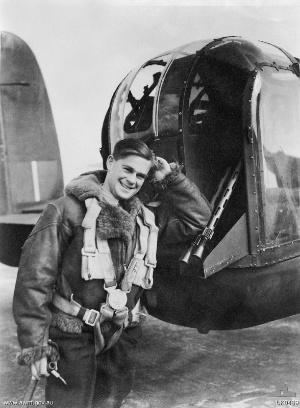Allegiance Australia Battles and wars World War II Name Roberts Dunstan | Battles/wars Second World War Years of service 1940–1945 Rank Flight lieutenant | |
 | ||
Other work Minister of Water SupplyMinister of Public Works Service/branch | ||
Roberts Christian "Bob" Dunstan DSO (5 November 1922 – 11 October 1989) was an Australian soldier and aviator during the Second World War. He was notable, among other things, for:
Contents
Dunstan was born in Bendigo, Victoria on 5 November 1922 and attended Geelong Grammar School between 1934 and 1939.
Australian Army
On 3 June 1940, five months before his 18th birthday, Dunstan joined the Australian Imperial Force.
After training with the Royal Australian Engineers, he was posted as a reinforcement to the 2/8th Field Company, in North Africa.
In January 1941, during the Allied campaign to capture Tobruk, Dunstan was wounded in the knee; the wound became infected and later required the amputation of Dunstan's leg. After recuperating in Egypt, Dunstan was returned to Australia and medically discharged.
Royal Australian Air Force
After a brief return to civilian life, during which he studied law, Dunstan volunteered for service overseas with the Royal Australian Air Force. In 1942 he trained as an air gunner at Port Pirie. At the end of his course, Dunstan embarked for the United Kingdom with the rank of Sergeant.
He was posted, as a rear gunner, to No. 460 Squadron RAAF, an Avro Lancaster unit at RAF Binbrook, in Lincolnshire. He flew his first operation, to Düsseldorf, on 11 June 1943 . In October he was commissioned as a Pilot Officer.
During a raid on Kassel on 22/23 October 1943, the plane in which he was flying was hit by two incendiary bombs dropped by another Lancaster, which was off course. The damage caused by this accident cut off the oxygen supply to Dunstan and the other gunner, Flight Sergeant Hegarty. As a result of the oxygen starvation that both men suffered, neither saw the approach of an enemy night-fighter, whose attack badly damaged the Lancaster, one cannon shell passing through the rear-gunner's turret. The aircraft managed to return home and make a crash-landing at Bisham, the crew escaping unhurt.
Dunstan completed a full tour of 30 operations and returned to Australia in August 1944, and was awarded the Distinguished Service Order for his efforts as a "Cool and skilful Air Gunner despite handicap of one leg".
He was discharged from the Royal Australian Air Force on 2 October 1945.
Politician, journalist and film critic
Dunstan attracted the attention of the media due to the unique nature of his experiences: an army and air force veteran, who had completed a full tour of 30 missions despite being an amputee.
He wrote about his experiences in a book, The Sand and the Sky, and took a job as a journalist and film critic with the Melbourne Herald.
After serving as local councillor, Dunstan stood for the Victorian parliament as a Liberal candidate. Between 1956 and 1982 he was the member for Mornington. Dunstan also held two ministerial posts, with responsibility for (firstly) water supply and (secondly) public works. Dunstan died in Melbourne on 11 October 1989.
